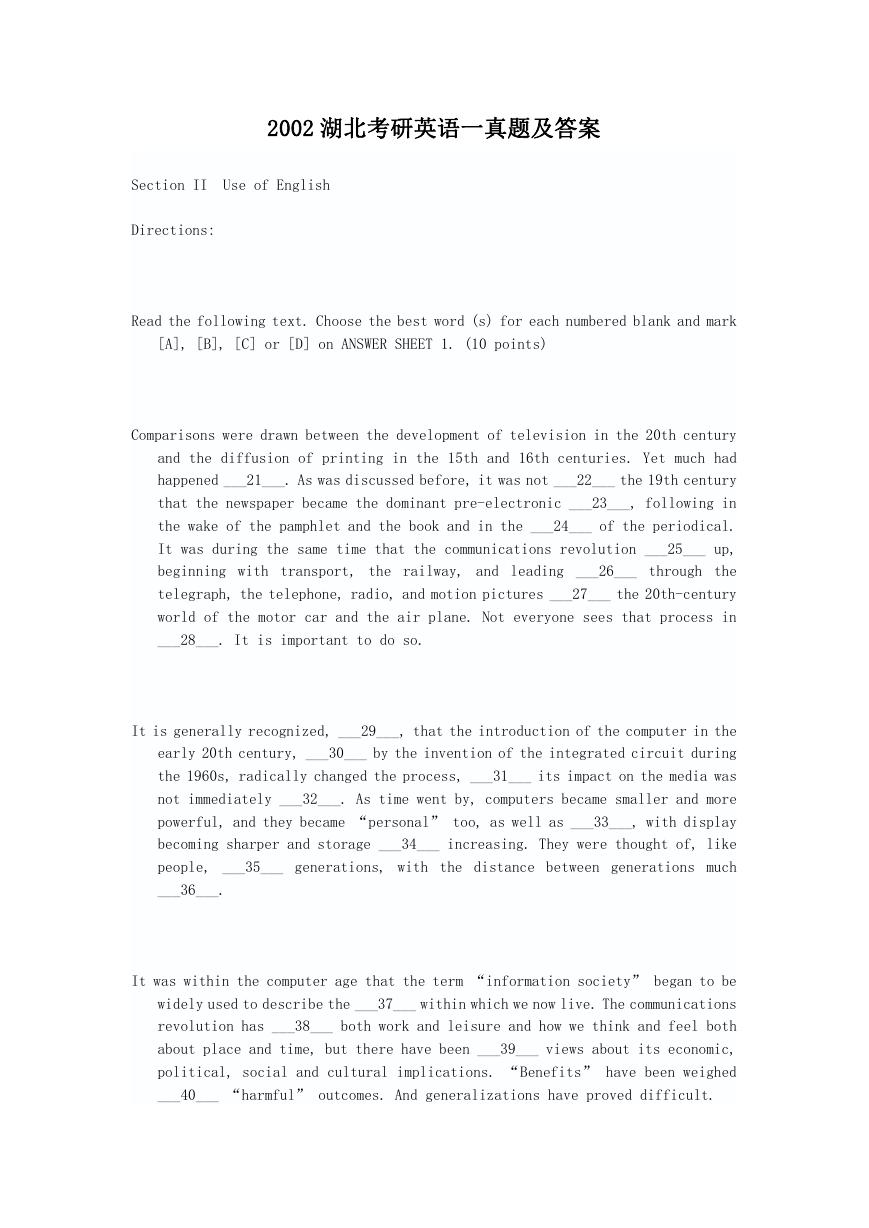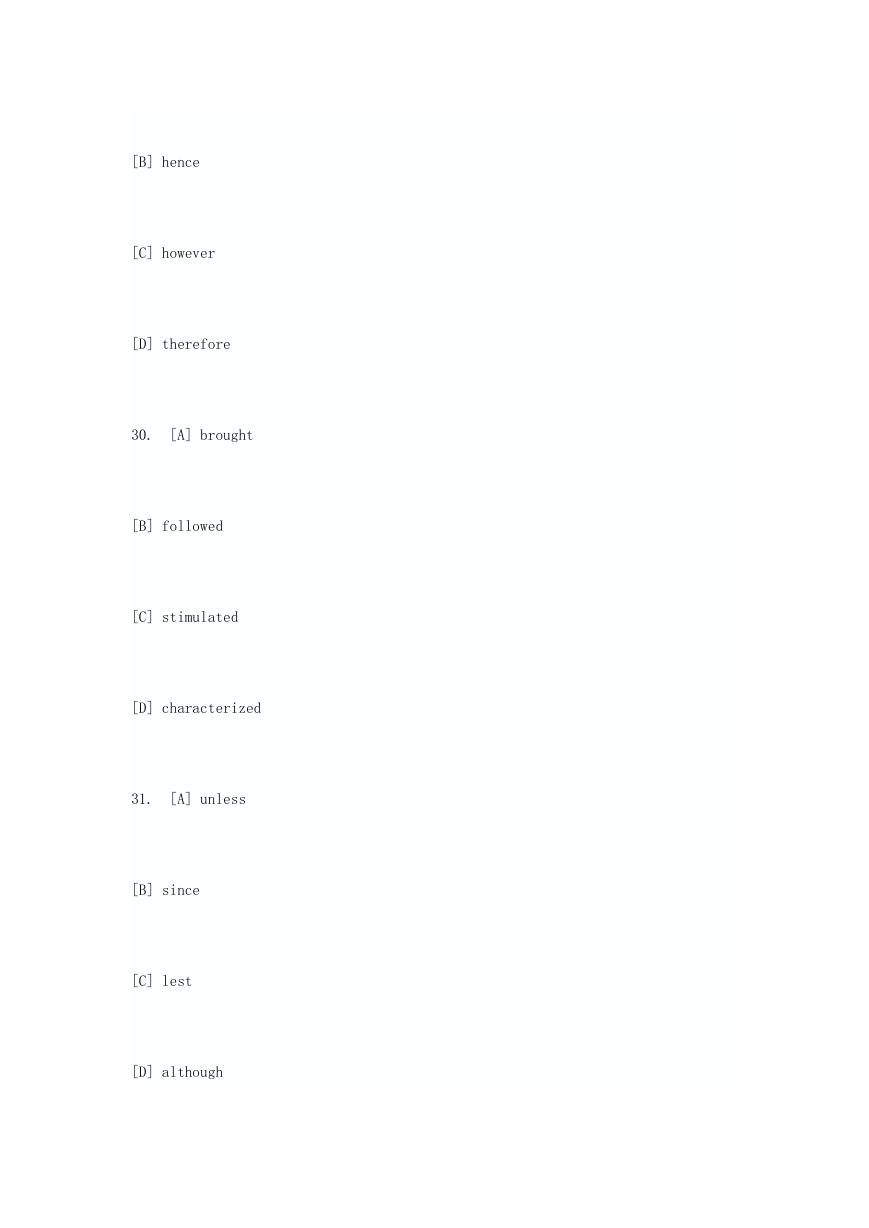2002 湖北考研英语一真题及答案
Section II
Use of English
Directions:
Read the following text. Choose the best word (s) for each numbered blank and mark
[A], [B], [C] or [D] on ANSWER SHEET 1. (10 points)
Comparisons were drawn between the development of television in the 20th century
and the diffusion of printing in the 15th and 16th centuries. Yet much had
happened ___21___. As was discussed before, it was not ___22___ the 19th century
that the newspaper became the dominant pre-electronic ___23___, following in
the wake of the pamphlet and the book and in the ___24___ of the periodical.
It was during the same time that the communications revolution ___25___ up,
beginning with transport, the railway, and leading ___26___ through the
telegraph, the telephone, radio, and motion pictures ___27___ the 20th-century
world of the motor car and the air plane. Not everyone sees that process in
___28___. It is important to do so.
It is generally recognized, ___29___, that the introduction of the computer in the
early 20th century, ___30___ by the invention of the integrated circuit during
the 1960s, radically changed the process, ___31___ its impact on the media was
not immediately ___32___. As time went by, computers became smaller and more
powerful, and they became “personal” too, as well as ___33___, with display
becoming sharper and storage ___34___ increasing. They were thought of, like
people, ___35___ generations, with the distance between generations much
___36___.
It was within the computer age that the term “information society” began to be
widely used to describe the ___37___ within which we now live. The communications
revolution has ___38___ both work and leisure and how we think and feel both
about place and time, but there have been ___39___ views about its economic,
political, social and cultural implications. “Benefits” have been weighed
___40___ “harmful” outcomes. And generalizations have proved difficult.
�
21.
[A] between
[B] before
[C] since
[D] later
22.
[A] after
[B] by
[C] during
[D] until
23.
[A] means
[B] method
[C] medium
�
[D] measure
24.
[A] process
[B] company
[C] light
[D] form
25.
[A] gathered
[B] speeded
[C] worked
[D] picked
26.
[A] on
[B] out
�
[C] over
[D] off
27.
[A] of
[B] for
[C] beyond
[D] into
28.
[A] concept
[B] dimension
[C] effect
[D] perspective
29.
[A] indeed
�
[B] hence
[C] however
[D] therefore
30.
[A] brought
[B] followed
[C] stimulated
[D] characterized
31.
[A] unless
[B] since
[C] lest
[D] although
�
32.
[A] apparent
[B] desirable
[C] negative
[D] plausible
33.
[A] institutional
[B] universal
[C] fundamental
[D] instrumental
34.
[A] ability
[B] capability
[C] capacity
�
[D] faculty
35.
[A] by means of
[B] in terms of
[C] with regard to
[D] in line with
36.
[A] deeper
[B] fewer
[C] nearer
[D] smaller
37.
[A] context
[B] range
�
[C] scope
[D] territory
38.
[A] regarded
[B] impressed
[C] influenced
[D] effected
39.
[A] competitive
[B] controversial
[C] distracting
[D] irrational
40.
[A] above
�
















 2023年江西萍乡中考道德与法治真题及答案.doc
2023年江西萍乡中考道德与法治真题及答案.doc 2012年重庆南川中考生物真题及答案.doc
2012年重庆南川中考生物真题及答案.doc 2013年江西师范大学地理学综合及文艺理论基础考研真题.doc
2013年江西师范大学地理学综合及文艺理论基础考研真题.doc 2020年四川甘孜小升初语文真题及答案I卷.doc
2020年四川甘孜小升初语文真题及答案I卷.doc 2020年注册岩土工程师专业基础考试真题及答案.doc
2020年注册岩土工程师专业基础考试真题及答案.doc 2023-2024学年福建省厦门市九年级上学期数学月考试题及答案.doc
2023-2024学年福建省厦门市九年级上学期数学月考试题及答案.doc 2021-2022学年辽宁省沈阳市大东区九年级上学期语文期末试题及答案.doc
2021-2022学年辽宁省沈阳市大东区九年级上学期语文期末试题及答案.doc 2022-2023学年北京东城区初三第一学期物理期末试卷及答案.doc
2022-2023学年北京东城区初三第一学期物理期末试卷及答案.doc 2018上半年江西教师资格初中地理学科知识与教学能力真题及答案.doc
2018上半年江西教师资格初中地理学科知识与教学能力真题及答案.doc 2012年河北国家公务员申论考试真题及答案-省级.doc
2012年河北国家公务员申论考试真题及答案-省级.doc 2020-2021学年江苏省扬州市江都区邵樊片九年级上学期数学第一次质量检测试题及答案.doc
2020-2021学年江苏省扬州市江都区邵樊片九年级上学期数学第一次质量检测试题及答案.doc 2022下半年黑龙江教师资格证中学综合素质真题及答案.doc
2022下半年黑龙江教师资格证中学综合素质真题及答案.doc